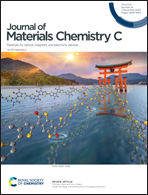Near-infrared light-emitting electrochemical cells based on the excimer emission of a cationic iridium complex†
Abstract
Near-infrared (NIR) light-emitting devices with organic semiconductors have great potential for applications in bio-imaging, telecommunication, night-vision displays, and chemical sensing. Light-emitting electrochemical cells (LECs) have demonstrated the advantages of a simple and solution-processable device architecture, low operation bias, and compatibility with air-stable cathode metals. To obtain pure and efficient NIR EL with an emission peak close to or exceeding 800 nm, we fabricated NIR LECs based on the excimer formation of the red cationic iridium complex (NIRex). NIR LECs that employ neat films of complex NIRex exhibit NIR EL centered at 860 nm. To further improve device efficiency, complex RED is incorporated to disperse complex NIRex to reduce concentration quenching. Increasing the incorporation amount of complex RED (0 to 60 wt%) to disperse the guest complex NIRex leads to blue-shifted EL (ELmax = 860 to 744 nm), an enhanced output power (143 to 637 μW cm−2) and an improved EQE (0.26 to 0.82%). The output power and EQE obtained in this work are rather high among the reported NIR LECs exhibiting EL emission peaks exceeding 750 nm. Therefore, NIR LECs based on excimer formation in thin films of cationic iridium complexes have great potential as efficient NIR light sources.



 Please wait while we load your content...
Please wait while we load your content...